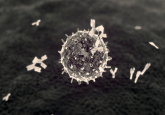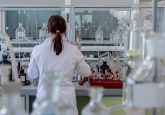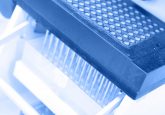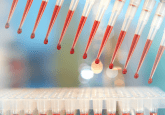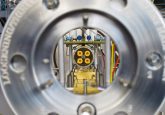Hybrid assays: an interview with Barry Jones and Adriane Spytko
About the speakers
 Barry Jones, PhD
Barry Jones, PhDDirector, LC–MS Biologics
Q² Solutions (NY, USA)
Barry Jones leads the large molecule LC/MS team at Q² Solutions (NY, USA). After receiving his PhD in Physical Chemistry from Binghamton University (NY, USA), Barry led the University’s Mass Spectrometer Core facility for proteomic research until joining Q² Solutions (then Advion) in 2007. Research within the LC–MS biologics group at Q² Solutions is focused on targeted quantitative LC–MS analysis of endogenous biomolecules and large molecule biotherapeutics on triple quadrupole and orbitrap instruments. Dr Jones is particularly interested in the application of hybrid Immunoaffinity-LC–MS, high-resolution mass spectrometry and low-flow chromatography techniques to drive sensitivity and selectivity of high-throughput, regulated bioanalytical methods, as well as the scientific challenges and validation strategies for LC–MS biomarker assays supporting drug development.
 Adriane Spytko
Adriane Spytko
Manager, LC–MS Biologics
Q² Solutions (NY, USA)
Adriane has 14 years of experience in regulated bioanalysis spanning both the immunoassay and LC−MS disciplines. She has developed and validated hundreds of quantitative immunoassays and brings these scientific and regulatory perspectives to our hybrid IA-LC/MS methods. Throughout her career, Adriane has managed multiple scientific departments and bioanalytical operations that give her experience from many viewpoints. Adriane currently manages the Instrument Operations Team in the LC−MS Biologics Production Group at Q2 Solutions.
Questions
Q) Should IA-LC/MS methods expect the same problems immunoassays have with critical reagents?
Adriane: So, immunoassay’s performance is entirely dependent on critical reagents because it requires a capture and a detection reagent. Critical reagents can affect our IA/LC−MS methods as well, but it shouldn’t always be assumed that they have the same level of impact as they do with immunoassays. Both IA/LC−MS methods and immunoassays capture the analyte. But IA/LC−MS methods aren’t dependent on that downstream binding of the analyte to the detection antibody as an immunoassay is. The IA/LC−MS method is specific for that signature peptide derived from that digested analyte. So, it makes it less reliant on that capture antibody binding to that specific protein epitope. We also have more tools for IA/LC−MS methods such as adding a stable isotope labeled protein level IS to normalize the whole extraction process, rather than just using that peptide SIL and other technique we can use to lessen the impact of critical reagents.
Q) What thoughts do you have regarding bottom-up LC−MS methods and the concern about detecting analyte that is not intact?
Barry: Sure. Yes, there has been a lot of effort to measure large proteins by LC−MS in an intact state or with minimal fragmentation that still gives you whole molecule information. But that hasn’t made its way into mainstream regulated bioanalysis at this point, and I understand the concern over using a peptide fragment as a representation of the impact protein with our bottom-up methods. It’s known that the measure of concentration of a protein with such a bottom-up strategy may depend on the selected signature peptide, and so, how do we control for that?
Careful selection of the peptide with respect to uniqueness and the lack of post-translational modification liabilities is of course important, and we can think about improving sequence coverage of the targeted measurement by following additional peptides for qualitative information where possible. That can give us more confidence in our quantitative measurements, especially when those additional peptides can give information about the intactness of the protein. Now, I do appreciate that an immunoassay may measure the target protein in its intact state, but such a measurement still does not give whole molecule information, either. It’s rather based on binding events. I believe the epitome of confidence may come from intact protein measurements by LC-MS.
Q) What are your thoughts about achieving a LLOQ in an immunoassay versus LC−MS?
Adriane: So, immunoassay sensitivities – they are limited by the quality of critical reagents. So, if you have an immunoassay that needs an aggressive LLOQ, if it’s identified that you are using the best critical reagents already and you have tried changing the minimum required dilutions or the MRD, you have tried different assay buffers, blocking reagents and immunoassay platforms, and that doesn’t get you the required sensitivity that you need, there’s limited techniques that are left to be tried to get that LLOQ and ensure that it’s robust in accuracy and precision evaluations and ensure that there’s no matrix effects and all the individual lots, both normal and disease that you test spike at the LLOQ.
So, this often requires if you have an LLOQ that’s aggressive in immunoassays, it needs to be raised if the concentration is low, if you keep it on the immunoassay platform. With LC−MS, we have a lot more tools in our toolbox we can use to get these aggressive LLOQs. In addition to using that and the immunocapture initial step, we can get further sensitivity through low flow chromatography and downstream use of an anti-peptide column that utilize it as an antibody capture of the signature peptide we are following. We couple this to high resolution mass spectrometers that give better sensitivity through greater selectivity, and we can achieve the ultimate sensitivity when it’s needed.
Q) What is key for setting up regulatory procedures regarding IA-LC/MS assays?
Adriane: Yes, so IA/LC−MS methods – they are considered immunoassays that use a mass spectrometer as a detector. So, these are hybrid methods and they span both immunoassay and LC−MS disciplines. And because of that, we need to take into account regulatory guidance for both, when we are validating and using these methods for sample analysis. So, at Q2 Solutions, we have created SOPs specific for the validation and to conduct sample analysis for these hybrid methods using our diversity of individuals from both the LC−MS and the immunoassay fields. By doing so, it was quite challenging because each section and the guidance needs to be reviewed and the experimental design and the acceptance criteria applied based on the understanding of the regulatory guidance, the intent of the experiment, the familiarity of the method being validated and the knowledge of both LC−MS and immunoassays.
Q) What would you like to be known about the time a biologics LC−MS method takes to develop, validate, and run samples?
Barry: Yes, this depends on the specific assay configuration, but generally, we can move pretty fast with an LC−MS assay on the development piece. Often, when we are presented with a protein therapeutic assay challenge, it’s because the immunoassay development efforts didn’t yield the performance needed to support that program. Often that’s related to the quality of the reagents and such reagents, though may work perfectly fine with a hybrid IA/LC−MS assay, where more degrees of selectivity are available. So, the long timelines that are associated with reagent generation can be eliminated. Exception to this is when we use anti-signature peptide antibody enrichment. And Adriane mentioned this, when we are going for ultimate sensitivity, these reagents aren’t commercially available nor are they likely to have been generated previously under an LBA assay format assumption.
Otherwise, we can start from scratch to develop the assay relatively quickly when reagents don’t need to be generated. Now keep in mind that the LC−MS analysis time is longer than LBA. Additional steps like denaturation, reduction, alkylation, digestion – they all add time, sometimes days to the sample preparation aspect. And the chromatographic separation adds to the runtime compared to LBA, bringing in low flow and multi-dimensionality in the LC that adds additional throughput challenges. But still in our lab, we can run a sample of three column chromatography and 600 nl/per minute flow rates in 10 to 12 minutes injection to injection by optimizing routines.
Q) What would be the most important point you learned about the LC−MS biologics field?
Barry: Sure. I think it’s the importance of diverse teams. It’s so interdisciplinary, incorporating elements of immunoassay and LC−MS platforms, of course, but also, of underlying biology, chemistry, physics, proteomics, bioinformatics, etc. And all of this is under an umbrella of compliance to regulatory rigor. One person can’t cover all aspects of this with their own experiences. So, we have to hire teams with a breadth of expertise. It can be a challenge to build and manage these teams, but it is critical to tackle complex biological and analytical problems with a comprehensive approach, and ultimately to help advance new therapies with confident, careful measurements.
Adriane: So, I think the importance of not pursuing an immunoassay first, instead of an LC−MS method, if there’s a low LLOQ required and/or you have a question on the quality of the critical reagents or lack of their ability. We have often seen requests for methods where an immunoassay was attempted first and the required LLOQ wasn’t achievable. So, this leads to the shortened timelines for the customer to have a lab develop and validate an LC−MS method because an immunoassay platform won’t work frequently. LC−MS methods are the only method available to get these LLOQs that are required when they are so low. When time is taken to first attempt the methods on immunoassay platforms rather than going directly to an IA/LC−MS method it takes up valuable time that can delay data delivery.
Q) What plans do you have for future projects that bridge LC−MS and LBA?
Adriane: So, we are currently working on an ADA, that’s anti-drug antibody by LC−MS method. We do see value in one method that can screen, confirm and measure the level of ADA and even isotype if needed. So, one method that can give all that information with a single analysis of the sample as opposed to at least three analyses using the immunoassay platform comes with significant challenges. Seen in the industry research papers, the main challenge amongst many with ADA by LC−MS methods is nonspecific binding of human Ig to the beads. So, using our experience of running an ADA by LC−MS assay in the past here and our expertise with hybrid IA/LC−MS methods and immunoassays, we were able to mitigate nonspecific binding of human Ig to the beads. So, we are currently proceeding forward with further evaluation of the ADA by LC−MS method, incorporating the positive control to assess specificity and drug tolerance and mitigating target interference.
Barry: Yes, a couple of different directions I would like to go in are opposite ends of the chromatography spectrum if you will. For those applications where the ultimate sensitivity is required, Q2 Solutions will continue to investigate new approaches to improve robustness and throughput. The dimensionality of the LC configuration gives us options that we are working to leverage. We have used affinity chromatography and size exclusion chromatography separately in conjunction with reverse phase chromatography, and there’s more combinations to explore.
On the other end of that spectrum where bioanalytical applications don’t require high sensitivity, is there room to improve existing LBA assay formats with a mass spec detector? And here I mean, without LC. You know for those that think we can never have a regulated PK essay without LC, well, we do that with immunoassays all the time. I think it’s possible. With replacement of the detection antibody in a typical ligand binding assay, with a mass spectrometer, a quick analysis approach like acoustic ejection spectrometry, or matrix-assisted laser desorption. Would these add value to an immunoassay with additional degrees of selectivity without that chromatographic separation? That’s an avenue I would like to explore.
In association with:


